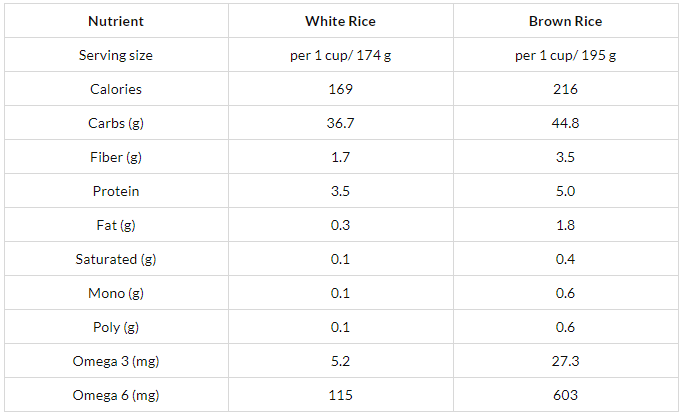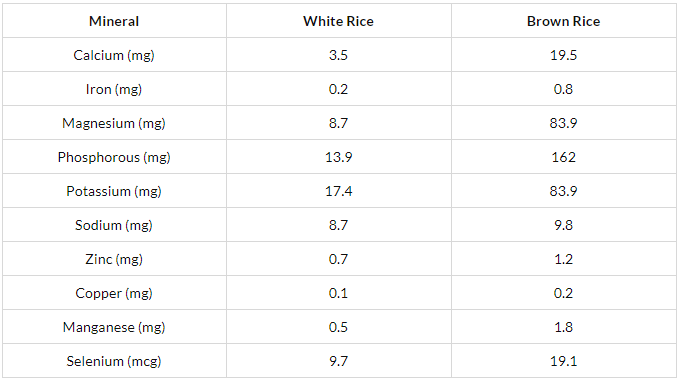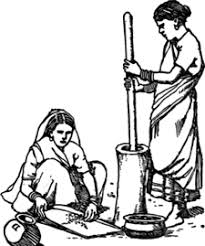Brown rice vs White rice
While everything white is categorized as refined, and processed, white rice too got pushed into the black list of foods. When the West started switching from white bread to brown bread, the developing south east Asian countries started aping them by switching from white rice to brown rice.
Even though most rice eating Asian countries like India, Japan and China have had rice as their staple diet for several centuries and civilizations they never ate brown rice. Is there something that we are missing out while we are busy reading the internet and switching to brown rice?
What is brown rice and what is white rice
Brown rice is the whole grain, where only the inedible part, the hull is removed. Hence, experts claim that most nutritious parts are intact. On the other hand, white rice gets the white colour as the hull and bran and is removed, either by milling or hand pounding.
Let’s compare on many fronts, which is better and why.
- Nutrients
The chart below gives us the glimpse of nutrient value of brown rice and white rice.


Brown rice is better than white rice in nutrient content. Does that mean it is good to consume it? Let us look at the other factors too.
2. Anti nutrients – Phytates ,Lectin and Fibre
Though brown rice has significantly higher vitamin and mineral content, the same cannot be absorbed by our body as it has anti nutrients such as phytates, lectins and fibre which binds to the minerals and vitamins. Phytates also inhibit some of the digestive enzymes like amylase, pepsin and trypsin. Lectins can penetrate the intestinal lining, interfere with nutrient digestion and absorption. Though brown rice is well marketed now as we are made to believe it is a great source of fibre, this fibre isn’t so easy to digest.
3. Digestibility
As the bran and germ are still intact in brown rice, it is tough to digest. Brown rice aggravates or in some cases even cause leaky gut( a condition where undigested food particles enter blood stream from gut/intestine) and Irritable Bowel Syndrome as it Is difficult for our intestine to break down the bran and germ. When we wean off infants, we start them on white rice or par boiled rice and this shows how safe and easy it is for us to digest it.
4.Arsenic and Heavy Metals
Arsenic is a heavy metal and is toxic to humans, especially the inorganic type( comes in the soil due to pesticides and fertilizers). Arsenic in the soil is absorbed more by rice plant compared to other grains like millets or wheat. This inorganic arsenic comes from pesticides and fertilizers. In many studies and tests conducted for testing arsenic it was found that brown rice had 50-80% more arsenic than white rice.
5. GI and GL – Glycaemic index and Glycaemic load
The glycaemic index indicates how rapidly a carbohydrate is digested and released as glucose (sugar) into the blood stream. Glycaemic load is a ranking system for carbohydrate-rich food that measures the amount of carbohydrates in a serving of food.
GI and GL of White rice is slightly higher than brown rice. Since we don’t eat rice by itself, and is eaten either with a pulse or vegetable and a little amount of fat, like we do in khichdi, Pongal, sambar rice, pulav or even idli/dosa , the food is digested and glucose is realised into blood slowly and steadily.
6. Taste matters
Even the best nutrition experts and fitness trainers will agree upon the fact that white rice tastes much better than brown rice. White rice wins hands down .
The west has recently started talking about a new type of rice, called converted rice. It is better known as parboiled rice to us in India. Par boiled rice is made by partially cooking it in hot water or steaming under pressure and then drying before milling. Due to this procedure Parboiled rice retains all nutrients of brown rice and is easier to digest. This is a reason most Indian communities start feeding infants a porridge made of parboiled rice when they introduce solids. Parboiled white rice is easily fermented (fermentation is the breakdown of the glucose by beneficial bacteria) and hence used for making idli and dosa in southern parts of India.

Picture showing how rice was hand pounded and winnowed in ancient times.
Our ancestors hand pounded rice to remove the hull and bran long before machines came. If brown rice was the best food, do you think they would have wasted time and energy pounding the rice. Now, after several centuries, we have evidence after conducting research that diet consisting of brown rice is not better than white rice due to its anti-nutrients which might do more harm than good.
If you found this post informative, share it with your friends too.

In paraboiling the rice, I think adding alpha lipoic acid to the rice,
should chealate the arsenic out of the rice.
This should reduce the arsenic in the rice way more than just
paraboiling it.